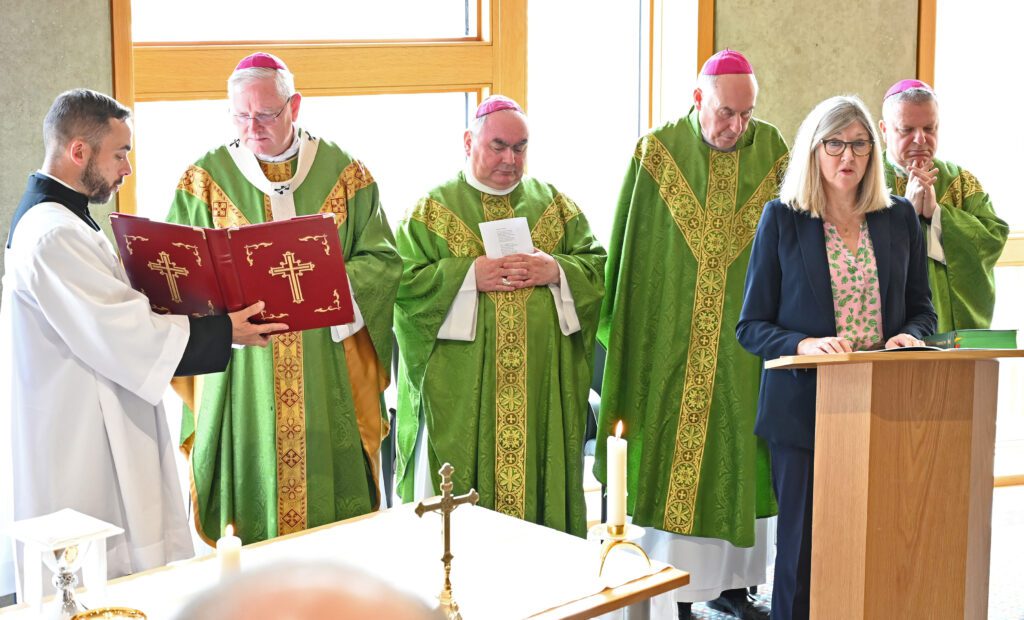"I never considered how profoundly grounded in love and humanity the Catholic faith was," says Ilhan Alp Yilmaz.
The 23-year-old student from Turkey is one of 33 people, mostly young adults, from St James' Parish in St Andrews who will become Catholic at Easter.
Ilhan says he was drawn to Catholicism by "a sincere feeling of thankfulness for everything in my life".
He has enjoyed the Rite of Christian Initiation of Adults (RCIA) process at the parish: "Learning something new each week about the faith, made endlessly entertaining by Monsignor Burke's wit."
'Looking for transcendence'
 A recent survey commissioned by the Bible Society and conducted by YouGov found what many priests have noticed over the last few years: more young adults are attending Church.
A recent survey commissioned by the Bible Society and conducted by YouGov found what many priests have noticed over the last few years: more young adults are attending Church.
Monsignor Patrick Burke, left, parish priest at St James', said: "I think it's happening because young people are aware of a certain of a certain shallowness in contemporary culture and are looking for deeper truth and meaning.
"I think they are also looking for community and belonging and a recognition that much of what is promised by contemporary celebrity culture does not actually yield deep happiness.
"When I was based at St Mary's Cathedral in Edinburgh, we were amazed by the number of young people who wanted to join RCIA.
"The Catholic Church offers meaning, beauty, truth, and transcedence...I think they are looking for transcendence."
'Quiet courage of young people'
This Saturday, Archbishop Cushley will celebrate the Easter Vigil Mass at 8:00pm in St Mary's Cathedral in Edinburgh, where 12 catechumens and 21 candidates will be received into Full Communion with the Catholic Church.
He said: "The quiet courage of any young person choosing faith is a sign that God is still at work in our world.
"Perhaps more young people are discovering in the Christian faith something deeper—something lasting. A peace and a sense of belonging - not to a “feed”, but to a family of faith that stretches back 2,000 years and reaches into eternity.
"The world feels overshadowed by suffering— the horror of war in Ukraine, in the Holy Land, and by civil and political unrest in the places we once looked to for security and stability.
"In the face of that, we look for truth, for reality, and for some common sense."
Alex Peris, 20, St James' Parish
 Alexander Peris, 20, is one of the group from St James' Parish who will become Catholic at Easter.
Alexander Peris, 20, is one of the group from St James' Parish who will become Catholic at Easter.
The student, from Pittsburgh, Pennsylvania, said: "When I arrived at St Andrews, one of the people I became good friends with was Catholic, and over the course of many conversations I became more open to Christianity as a whole.
"Then I started going to Mass and reading more about the faith and it all clicked.
"Catholicism’s historical roots and internal consistency appealed to me.
"I realised that my entire understanding of morality and Western civilization was wholly dependent on the teachings of Christ and his Church.
"I look forward to continuing to build a prayer life and deepening my faith.
"I’m also looking forward to exploring the Catholic community in my hometown of Pittsburgh."
Jessica Hrycak, 19, St James' Parish
 Jessica, from Milton Keynes, said: "I was raised in a Christian household, but it wasn’t until University that I decided to take my religion more seriously.
Jessica, from Milton Keynes, said: "I was raised in a Christian household, but it wasn’t until University that I decided to take my religion more seriously.
"My friends in Halls would always have religious debates at meal times, and this is how I began learning about Catholicism.
"From there, I started going to Mass, as their conversations had drawn me to the Catholic church.
"I then started RCIA as a way to learn more about God, and what it means to be a Catholic.
"(I've enjoyed) learning about Catholic devotions, and the history of the Church.
"My friends at University have all always been here for me. I have never felt any judgement, and they are always willing to answer any questions I may have."
Ilhan Alp Yilmaz, 23, St James' Parish
 Ilhan, from Istanbul, said: "My sister and I were raised irreligious, and so my knowledge of any religion was rather slim.
Ilhan, from Istanbul, said: "My sister and I were raised irreligious, and so my knowledge of any religion was rather slim.
"I never considered how profoundly grounded in love and humanity the Catholic faith was and I was surprised that its beliefs were holistic and not a series of disconnected doctrines.
"I've enjoyed learning something new each week about the faith."
And his hopes for the future as a new Catholic? "To keep the faith."
Aimee Koo, St Mary's Cathedral, Edinburgh
Aimee, a law and politics student at Stirling University, will be baptised at St Mary’s Cathedral in Edinburgh.
Speaking on BBC Radio Scotland, she said: “I did a lot of research on YouTube, just to have confidence to know the step I am taking.
“(RCIA) has been great. Every question you have they will answer. The catechists are volunteers and they’re very knowledgeable - they use so much of their spare time helping us and all the other catechumans.
“You do get a strong community within churches so I'm very blessed that it wasn't too much of a struggle.”
The Easter Vigil takes place at St Mary’s Cathedral in Edinburgh on Saturday Saturday 19 April at 7:00pm. To find out more about the RCIA programme at the Cathedral contact cathedralhouse@stmaryscathedral.co.uk. Download the Quiet Revival study here.









 A
A  Alexander Peris, 20, is one of the group from St James' Parish who will become Catholic at Easter.
Alexander Peris, 20, is one of the group from St James' Parish who will become Catholic at Easter. Jessica, from Milton Keynes, said: "I was raised in a Christian household, but it wasn’t until University that I decided to take my religion more seriously.
Jessica, from Milton Keynes, said: "I was raised in a Christian household, but it wasn’t until University that I decided to take my religion more seriously. Ilhan, from Istanbul, said: "My sister and I were raised irreligious, and so my knowledge of any religion was rather slim.
Ilhan, from Istanbul, said: "My sister and I were raised irreligious, and so my knowledge of any religion was rather slim.